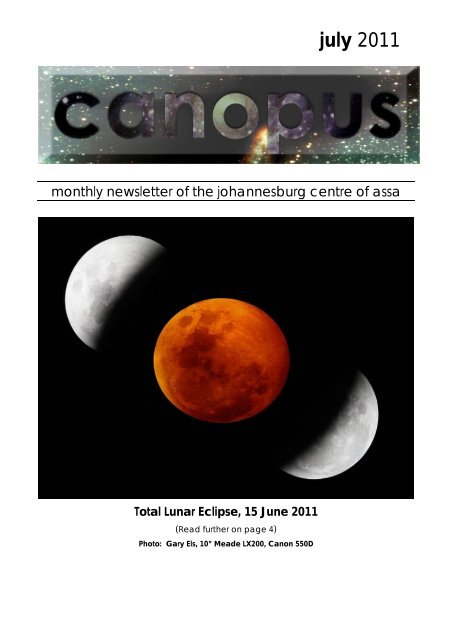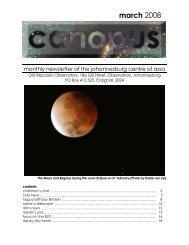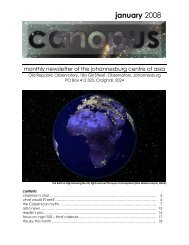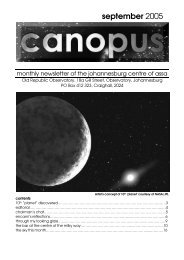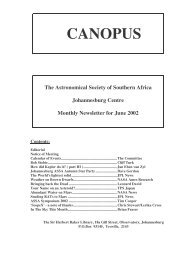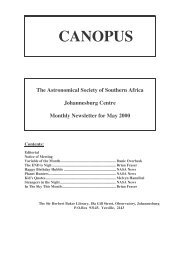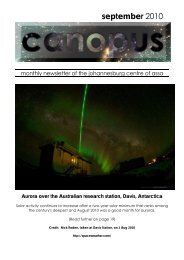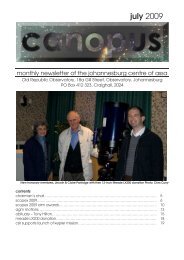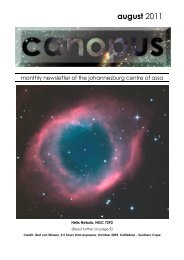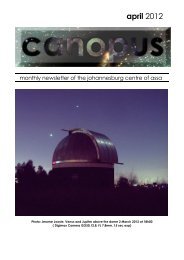july 2011 - Astronomical Society of Southern Africa
july 2011 - Astronomical Society of Southern Africa
july 2011 - Astronomical Society of Southern Africa
Create successful ePaper yourself
Turn your PDF publications into a flip-book with our unique Google optimized e-Paper software.
<strong>july</strong> <strong>2011</strong><br />
monthly newsletter <strong>of</strong> the johannesburg centre <strong>of</strong> assa<br />
Total Lunar Eclipse, 15 June <strong>2011</strong><br />
(Read further on page 4)<br />
Photo: Gary Els, 10” Meade LX200, Canon 550D
canopus <strong>july</strong> <strong>2011</strong><br />
page 2<br />
8 June <strong>2011</strong>: Space Shuttle and Space Station Photographed Together<br />
Credit: NASA (http://apod.nasa.gov/apod/ap110608.html)<br />
Do you want to advertise in<br />
Canopus?<br />
Canopus is widely read by more than 200 people every<br />
month and has been in circulation for more than 30 years!<br />
We have a number <strong>of</strong> options ranging from R110 to R385 per issue:<br />
Rates for advertorial space To June 2012:<br />
Full page, colour, inside cover R385<br />
Half page, colour, inside cover R192.50<br />
Full page, black and white R220<br />
Half page, black and white R110<br />
For more information please contact:<br />
Heather Dalgleish: Alec Jamieson:<br />
Cell: 082 417 6350<br />
Cell: 082 654 5336<br />
Email: hdalgleish@groupfive.co.za Email: alec.jamieson@telkomsa.net
Notice <strong>of</strong> Next Meeting – ASSA Johannesburg<br />
canopus <strong>july</strong> <strong>2011</strong><br />
Next meeting at Johannesburg Observatory, 18a Gill St, Observatory<br />
Wednesday, 13 July <strong>2011</strong> at 7.30 pm<br />
The Annual General Meeting <strong>of</strong> the ASSA Johannesburg Centre<br />
(Read more on page 8)<br />
Portfolio/Interest Name E-mail Contact Details<br />
Chairman Gary Els gels@randwater.co.za 082 389 2250<br />
Vice-Chairman Constant Volschenk starmanza@gmail.com 083 442 8169<br />
Secretary, Membership<br />
Secretary & Librarian<br />
Alec Jamieson alec.jamieson@telkomsa.net 082 654 5336<br />
Treasurer Heather Dalgleish hdalgleish@groupfive.co.za 082 417 6350 a/h<br />
Viewing Officer Eric Brindeau eric.brindeau@gmail.com 083 698 8310<br />
Curator <strong>of</strong> Instruments Michael Robins m.robins@ziehl-abegg.co.za 082 900 8371<br />
Asst. Curator <strong>of</strong> Instruments Dave Hughes --- 082 412 6665<br />
Public Relations Officer Sharon Tait labelconnection@mweb.co.za 082 455 0819<br />
Webmaster Barend Botha bjbotha@yahoo.com 083 284 3496<br />
Committee member Melvyn Hannibal Melvynh@iburst.co.za 011 435 6007<br />
ASSA Johannesburg Mailing Lists<br />
It is essential to join our mailing list to automatically receive alerts for all<br />
announcements, activity reminders; including public viewing, meetings, star parties<br />
and last minute changes.<br />
To subscribe or unsubscribe, merely post a blank e-mail to the indicated addresses:<br />
ASSA Announce<br />
General announcements for the<br />
Johannesburg Centre<br />
ASSA Canopus<br />
Distribution list for the PDF version <strong>of</strong><br />
our monthly newsletter, Canopus<br />
assajhb-subscribe@yahoogroups.com<br />
assajhb-unsubscribe@yahoogroups.com<br />
assacanopus-subscribe@yahoogroups.com<br />
assacanopus-unsubscribe@yahoogroups.com<br />
Canopus Team<br />
Editor: Eric Brindeau (eric.brindeau@gmail.com)<br />
Advertising: Alec Jamieson (alec.jamieson@telkomsa.net)<br />
Printing and Distribution: Alec and Sue Jamieson<br />
page 3
canopus <strong>july</strong> <strong>2011</strong><br />
Chairman’s Chat<br />
By Gary Els<br />
What a wonderful sight, the Total Lunar Eclipse on the 15 th <strong>of</strong> June — I trust many <strong>of</strong><br />
our members were able to experience this heavenly phenomenon. The next day I<br />
was watching BBC World News where they showed and interviewed people from<br />
Johannesburg and around the world during the event, all so overwhelmed at the<br />
beautiful red Moon. Those in Asia reported that the Moon had a more coppery<br />
colour due to the volcanic ash in the atmosphere.<br />
I spent the evening with a small group <strong>of</strong> friends in my observatory at home. Some<br />
had never seen a Lunar Eclipse before, and their amazement was wonderful to see.<br />
With my laptop attached to the camera on my telescope, we were able to see the<br />
Moon “live” on the screen and with each image captured and reviewed all were<br />
able to comment and make suggestions for the next exposure. It really gave a<br />
participatory feeling about the whole event, which I thoroughly enjoyed.<br />
Before eclipse day, I did some reading about Solar and Lunar eclipse stories<br />
throughout the ages on the Astronomy Today website, in order to share with my<br />
visitors, and I would like to mention just two <strong>of</strong> them from that site.<br />
Ho and Hi, the Drunk Astronomers (2137 BCE)<br />
page 4<br />
Throughout the centuries, Chinese astronomers devoted substantial efforts towards<br />
predicting eclipses. However, like all similar efforts prior to the Renaissance, this could only<br />
be by empirical research. The earliest record <strong>of</strong> a solar eclipse comes from ancient<br />
Chinese history since October 22, 2137 BCE. Ancient Chinese astronomy was primarily a<br />
governmental activity. It was the astronomer's role to keep track <strong>of</strong> solar, lunar and<br />
planetary motions and explain what they meant to the ruling emperor.<br />
Eclipse observation in China around 1840: Astronomers calmly observe an eclipse and the servants,<br />
terrified, prostrate themselves on the ground to placate the bad omen.<br />
According to legend, the royal astronomers Ho and Hi dedicated too much <strong>of</strong> their time<br />
to consuming alcohol and failed to predict a forthcoming eclipse. Traditionally, the solar
canopus <strong>july</strong> <strong>2011</strong><br />
eclipse recorded in the Shu Ching was regarded as having occurred the 3rd millennium<br />
BCE. On the first day <strong>of</strong> the month, in the last month <strong>of</strong> autumn, the Sun and the Moon did<br />
not meet (harmoniously) in Fang' ... so runs the text. The emperor became very unhappy<br />
because, without knowing that there was an eclipse coming, he was unable to organize<br />
teams to beat drums and shoot arrows in the air to frighten away the invisible dragon. The<br />
Sun did survive, but the two astronomers lost their heads for such negligence. Since then, a<br />
legend arose that no one has ever seen an astronomer drunk during an eclipse.<br />
Now I wonder if the legend <strong>of</strong> drunken astronomers is still true today!!? Of cause on<br />
eclipse night in the observatory, we were totally sober sipping a glass <strong>of</strong> wine.<br />
Christopher Columbus' Eclipse (1504 CE)<br />
After a long trip to the Americas in 1503, in his fourth voyage, Columbus was stranded on<br />
the island <strong>of</strong> Jamaica. In principle, he managed to obtain provisions from the Caciques<br />
natives in exchange for some trinkets and rubbish. As the months went by, novelty and<br />
hospitality started to decrease and also the sailors became more aggressive with the<br />
natives in order to obtain food. Then the native Jamaicans communicated to the Spanish<br />
that they would not provide any more supplies.<br />
Columbus became desperate with the<br />
threat <strong>of</strong> famine and came up with an<br />
ingenious plan. He checked his<br />
Calendarium, which contained<br />
predictions <strong>of</strong> lunar eclipses for several<br />
years. In particular, it predicted a total<br />
eclipse <strong>of</strong> the Moon on the Antilles on<br />
February 29, 1504 CE. That evening, he<br />
invited the Caciques on-board his<br />
Capitana for a serious conversation. He<br />
told them that they were Christians and<br />
their God did not like the way they had<br />
been treating them and would punish<br />
the Indians with famine and pestilence<br />
and, as a sign <strong>of</strong> dissatisfaction, he would darken the Moon. As soon as he said that, the<br />
Earth's shadow started to cover the white disk. Terrified, the natives begged Columbus to<br />
bring back the light.<br />
He replied that he needed to consult his God. He shut himself in a cabin for nearly two<br />
hours. Just before the end <strong>of</strong> totality, he reappeared and announced that God had<br />
given his pardon, and would bring them back the Moon provided that the Christians were<br />
given provisions. Immediately, the Moon reappeared. Astonished, the natives<br />
immediately provided Columbus and his crew their needed provisions until they were able<br />
to return to Europe.<br />
With all the nonsense doing its rounds again on the internet, such as two suns will appear<br />
in the night sky, it’s great to see real predictions being enjoyed by so many, and I hope<br />
no one was manipulated as Columbus did in 1504 AD.<br />
Gary<br />
page 5
canopus <strong>july</strong> <strong>2011</strong><br />
Notes on the Monthly Meeting<br />
By Melvyn Hannibal<br />
The evening commenced with feedback from Gary Els about the dark-sky weekend<br />
at Suikerbos Nature Reserve. He showed us some <strong>of</strong> his photos <strong>of</strong> the resort and some<br />
he took through our 12" telescope.<br />
Dave Blane gave us brief run down on his work with double stars, showing us photos<br />
<strong>of</strong> his equipment, and extracts from various double star catalogues.<br />
Constant Volschenk told us about the current night skies, and demonstrated the<br />
eclipse on the 15th.<br />
The main speaker was Jonny Rizos from the “South <strong>Africa</strong>n<br />
National Space Agency”. No, we are not going into<br />
competition with NASA.<br />
This local organisation is concerned with using satellites<br />
that observe the Earth. The Facility is based at<br />
Hartebeesthoek near Krugersdorp. The site was originally<br />
set up by the Americans, and then passed to the CSIR. In<br />
April this year SANSA was formed and given the use <strong>of</strong> the<br />
site. This is a Radio facility. The data is used to follow urban<br />
growth, land usage, and studies <strong>of</strong> that nature, and covers<br />
a circular area from three degrees South <strong>of</strong> the equator.<br />
This covers all <strong>of</strong> southern <strong>Africa</strong>.<br />
Melvyn<br />
page 6<br />
Right: Jonny Rizos, from SANSA (Photo: M Hannibal)<br />
Late News Item — 25 June: ASSA website http://assa.saao.ac.za/ states “ASSA<br />
constitution accepted”. The new draft constitution that has been accepted can be<br />
seen at http://assa.saao.ac.za/resource/ASSAConstitutionRedraft<strong>2011</strong>-05-26.pdf<br />
More information is expected to follow shortly on the consequences <strong>of</strong> the new<br />
constitution on ASSA Centres and will be notified via ASSA Announce maillist, placed on<br />
the website and in the next Canopus.<br />
Alec Jamieson - Secretary<br />
Upcoming Events<br />
Friday, 1 July <strong>2011</strong><br />
Public viewing<br />
Venue: Johannesburg Observatory, 18a Gill St, Observatory<br />
Starting time: 7:00pm
canopus <strong>july</strong> <strong>2011</strong><br />
Saturday, 2 July <strong>2011</strong><br />
Dark sky viewing from Suikerbosrand (members only)<br />
Venue: Suikerbosrand Nature Reserve, outside Heidelberg<br />
Time: gates close at 4pm<br />
Bring: chairs, food and drink (bring and braai)<br />
Contact: Constant - starmanza@gmail.com (have your car registration available)<br />
Wednesday, 13 July <strong>2011</strong><br />
The Annual General Meeting <strong>of</strong> the ASSA Johannesburg Centre<br />
Members will be able to nominate candidates for election to the Committee for<br />
the year ending June 2012 – read more on page 8<br />
Venue: Telescope Lecture Room, JHB Observatory, 18a Gill St, Observatory<br />
Starting time: 7:30pm<br />
Saturday, 23 July <strong>2011</strong> (RSVP by 15 July)<br />
ESSA/ASSA/ATM Star party - Exploration <strong>Society</strong> <strong>of</strong> <strong>Southern</strong> <strong>Africa</strong> (ESSA),<br />
<strong>Astronomical</strong> <strong>Society</strong> <strong>of</strong> <strong>Southern</strong> <strong>Africa</strong> (ASSA), Amateur Telescope Makers (ATM)<br />
Venue: Paul's farm, Magaliesburg, +/- 2 hour drive from Joburg or Pretoria<br />
(detailed directions and instructions will be sent by e-mail closer to the time)<br />
Time: it is advisable to arrive at about 15h00<br />
Cost: R30 for ESSA/ASSA/ATM members, R50 for non-members (children and<br />
people bringing telescopes free)<br />
Accommodation: camping available for diehards at R20 for the night<br />
Viewing opportunity: ASSA Jhb will be taking the 12" Meade to the event and<br />
members will have a chance so see how it performs under a dark sky<br />
RSVP: by 15 July, Simon Donally: donallys2@yahoo.fr<br />
Thursday, 28 July <strong>2011</strong><br />
Science in Science Fiction? Are Sci-Fi Futures far-fetched fantasy or feasible fact?<br />
Venue: Auditorium, Sci-Bono Discovery Centre, Miriam Makeba Street<br />
between Jeppe & President, Newtown, Joburg (secure lit parking available)<br />
Time: 6:30 for 7:00 pm<br />
RSVP: speaktoascientist@sci-bono.co.za<br />
Contact: Refilwe Pico (011 639 8448) for more information<br />
Friday 29 to Sunday 31 July <strong>2011</strong><br />
West Rand Astronomy Club Annual Star Party: all are welcome<br />
Venue: Mountain Sanctuary Park, Magaliesberg (private nature reserve, about<br />
120km north-west <strong>of</strong> Johannesburg and 90km west <strong>of</strong> Pretoria)<br />
Accommodation: options are chalets, log cabins or camping - telescopes will<br />
be set up in an open field between campsites 14 & 16<br />
Bookings: please contact Mountain Sanctuary Park @ Tel: (014) 534-0114<br />
(08H00-17H00, 7 Days a week), e-mail: owen@mountain-sanctuary.co.za, web:<br />
www.mountain-sanctuary.co.za<br />
Contact: Kenny Neville on 082 335 1983, email: kenny@wrac.org.za<br />
Program & further details: visit www.wrac.org.za<br />
page 7
canopus <strong>july</strong> <strong>2011</strong><br />
Monday 3 to Friday 7 October <strong>2011</strong><br />
62nd International Astronautical Congress<br />
Venue: Cape Town International Convention Centre<br />
Visit: http://iac<strong>2011</strong>.com for more information<br />
ASSA JHB AGM: Notice <strong>of</strong> Meeting – 13 July <strong>2011</strong><br />
The Annual General Meeting <strong>of</strong> Members <strong>of</strong> the ASSA Johannesburg Centre will be<br />
held in the Telescope Lecture Room at the Johannesburg Observatory on<br />
Wednesday 13 th July <strong>2011</strong>, commencing at 7:30 pm.<br />
Agenda<br />
1. Notice <strong>of</strong> meeting.<br />
2. Welcome<br />
3. Attendance / Apologies.<br />
4. Confirmation <strong>of</strong> the previous minutes.<br />
5. Office Bearers’ reports for the year ended 30th June <strong>2011</strong>:<br />
5.1. Chairman’s report, Gary Els.<br />
5.2. Treasurer's report, Heather Dalgleish.<br />
5.3. Membership Secretary and Librarian’s report, Alec Jamieson.<br />
5.4. Curator <strong>of</strong> Instruments report, Gary Els in the absence <strong>of</strong> Michael Robins.<br />
5.5. Observing report, Eric Brindeau.<br />
5.6. Astro-photography, Gary Els.<br />
6. Awards and prize giving.<br />
7. General.<br />
8. Final nominations for the election <strong>of</strong> Committee members.<br />
9. Voting.<br />
10. Results <strong>of</strong> the Committee election.<br />
11. Closure.<br />
12. Snacks and refreshments during vote counting.<br />
ASSA JHB Committee Election: Call for Nominations<br />
By Alec Jamieson<br />
Election <strong>of</strong> the <strong>2011</strong>/2012 committee will take place at the Annual General Meeting to<br />
be held on 13th July <strong>2011</strong>, and nominations <strong>of</strong> candidates for election to the committee<br />
are requested.<br />
Nominations must be in writing, and received by the Secretary by 11th July <strong>2011</strong>:<br />
page 8
canopus <strong>july</strong> <strong>2011</strong><br />
by hand;<br />
or by post to P. O. Box 412323, Craighall, 2024;<br />
or by e-mail to alec.jamieson@telkomsa.net ;<br />
or by fax to 011 886 7288. Note: this is a manual fax, please phone first.<br />
Late nominations will be accepted at the AGM at the discretion <strong>of</strong> the Electoral Officer<br />
and the names <strong>of</strong> late nominees will not appear on the voting form.<br />
There is no prescribed nomination form. For guidance, a typical nomination would take<br />
the form shown below.<br />
I, ............................................. nominate ......................................... for election to the<br />
Name printed Name printed<br />
<strong>2011</strong>/2012 ASSA Johannesburg Centre Committee.<br />
Seconded .................................... ................................................. ..............................<br />
Name printed Signature Date<br />
Accepted .................................... ................................................. ..............................<br />
Name printed Signature Date<br />
For a nomination to be valid, all names appearing on a nomination must be names <strong>of</strong><br />
members in good standing with the Centre.<br />
In the case <strong>of</strong> e-mail nominations, the Secretary will confirm the nominations<br />
telephonically, using telephone numbers recorded in the membership database.<br />
To encourage wider participation in the committee, more than the minimum 7 members<br />
may be elected. A committee must consist <strong>of</strong> at least a chairman, vice-chairman,<br />
secretary, treasurer and 3 other members. The newly elected committee chooses the<br />
chairman by consensus, and thereafter the chairman leads the discussion in the<br />
allocation <strong>of</strong> other responsibilities. For this reason it is not possible to nominate candidates<br />
for election to a particular position on the committee.<br />
New ideas are vital to any organisation, so recently joined members should not feel<br />
excluded from participating in the ASSA Jhb Centre Committee.<br />
Alec Jamieson, Secretary.<br />
New Members<br />
The Committee would like to welcome the following new members to the ASSA<br />
Johannesburg Centre:<br />
Member No Name<br />
1201 Norman Leibowitz<br />
1202 Kerry McArthur<br />
page 9
canopus <strong>july</strong> <strong>2011</strong><br />
M41 – Your Best Friend<br />
By Magda Streicher<br />
Canis Major is a special constellation because <strong>of</strong> its shape and the impression it creates<br />
for a star-lover. It houses bright and outstanding objects and, <strong>of</strong> course, the brightest star,<br />
Sirius.<br />
NGC 2287, also known as Messier 41, appears to be hiding itself under the belly <strong>of</strong> the<br />
doglike figure, like a bunch <strong>of</strong> fleas, about 4º south <strong>of</strong> Sirius. This beautiful cluster <strong>of</strong><br />
approximately 100 stars, which can be seen with the naked eye and partly resolved<br />
using binoculars, is moving away from us at about 34 km per second and is said to be<br />
about 24 light years across and 2 300 light years away.<br />
This is one <strong>of</strong> the few deep sky objects to have been recorded by the ancients: it was<br />
mentioned by Aristotle in 325 BC. It is one <strong>of</strong> the delights <strong>of</strong> the sky, with the grouping<br />
reminding me <strong>of</strong> a lovely flower opening its petals in clear curls and curved lines. Two<br />
rust-coloured stars, magnitude 6.8 and 7.3, remind me <strong>of</strong> pollen threads flowing out <strong>of</strong> a<br />
central crown consisting <strong>of</strong> a semi-circle <strong>of</strong> bright members. A swarm <strong>of</strong> faint stars covers<br />
the cluster like powder dust with a few dark patches between chains <strong>of</strong> faint stars. The<br />
magnitude 6 star 12 Canis Majoris shares the field <strong>of</strong> view towards the south-east.<br />
M41 – Like a flower opening its petals in clear curls and curved lines (Sketch: Magda Streicher)<br />
page 10
canopus <strong>july</strong> <strong>2011</strong><br />
Name Object RA: DEC: Magnitude Size<br />
M41 Open Cluster 06h41m.2 -20 o 44’52” 4.5 38.0’<br />
It is easy to make friends with fellow astronomers, as they are usually friendly and<br />
winsome people. Eric Brindeau, who was so helpful to me and did such an outstanding<br />
job at Canopus, became such a friend. Although, sadly, he will be leaving his position at<br />
the end <strong>of</strong> June, he remains a friend to me and to everyone else at Canopus.<br />
— Thanks Magda! Your articles have inspired me to find new and exciting objects. I wait<br />
in anticipation for your forthcoming book — Editor<br />
Magda Streicher<br />
magdalena@mweb.co.za<br />
Magda—a past President <strong>of</strong> ASSA—is a passionate deep-sky observer and views<br />
from excellent, dark skies on a farm close to the Zimbabwe border. Her fascination<br />
in the stars goes back to childhood and over the past 15 years has contributed<br />
greatly to visual astronomy in SA, helping to motivate others to observe and record<br />
deep-sky objects. Using 12” and 16” Schmidt-Cassegrain telescopes, she hunts<br />
down and sketches these faint fuzzies, sharing her interest through regular talks and<br />
articles. She contributes to various deep sky sections in SA as well as publications<br />
like Canopus and Deep Sky Delights, her regular deep sky column in MNASSA<br />
(Monthly Notes <strong>of</strong> the <strong>Astronomical</strong> <strong>Society</strong> <strong>of</strong> SA). Magda is currently working on<br />
her book “Astronomy Delights”, which she plans to finish towards the end <strong>of</strong> year.<br />
Satellite Phone Dish to be Turned into Telescope<br />
Submitted by Eric Brindeau<br />
http://www.irishtimes.com/newspaper/ireland/<strong>2011</strong>/0510/1224296602827.html<br />
The Irish Times - Tuesday, May 10, <strong>2011</strong>: A 32-metre satellite dish originally used in the<br />
1980s to take transatlantic calls from Europe to the US is to be reborn as a deep<br />
space radio telescope.<br />
The huge dish was originally constructed in Co Cork in 1984 but was retired in the<br />
mid-1990s when new fibre-optic transatlantic cables were laid.<br />
There are only a handful <strong>of</strong> these dishes remaining globally, many <strong>of</strong> which have<br />
fallen into disrepair.<br />
Right: Arek Pilat, a satellite engineer at Elfordstown<br />
Earthstation, Midleton, Co Cork, with the former<br />
telephone satellite dish which is to become a deep<br />
space radio telescope available to students for<br />
educational purposes.<br />
Photograph: Gerard McCarthy (Irish Times)<br />
page 11
canopus <strong>july</strong> <strong>2011</strong><br />
Yesterday at Elfordstown Earthstation, Midleton, Co Cork, Minister <strong>of</strong> State for<br />
Research and Innovation Seán Sherlock announced a partnership between the<br />
National Space Centre and Cork Institute <strong>of</strong> Technology (CIT) which will see the dish<br />
start a new life as a telescope. The telescope will be capable <strong>of</strong> detecting a host <strong>of</strong><br />
cosmic phenomena including the emission <strong>of</strong> giant, slow moving hydrogen clouds,<br />
the violent explosions <strong>of</strong> stars, eruptions <strong>of</strong> the solar surface and storms on Jupiter.<br />
It will be the only 32m radio telescope available to primary students for educational<br />
purposes in Europe.<br />
Phase one <strong>of</strong> the project will see the telescope operational by the end <strong>of</strong> this<br />
summer, with feeds available in September via the internet to primary and post<br />
primary schools.<br />
Phase two will occur in 2012 and will involve the refurbishment <strong>of</strong> the dish to enable it<br />
to turn as it originally did and the installation <strong>of</strong> sensors and new receivers. The<br />
project will be co-ordinated and operated by CIT under Dr Niall Smith, head <strong>of</strong><br />
research, and Blackrock Castle Observatory.<br />
Dr Smith said this project will see a €10 million radio telescope brought back to life for<br />
less than €10,000 thanks to the partnership between the National Space Centre and<br />
CIT.<br />
“It’s a great example <strong>of</strong> using world-class infrastructure in the most cost-effective<br />
way to reach out into the community and to embed our growing scientific heritage<br />
alongside our world-renowned culture.<br />
“It will excite students in schools who will get to listen in on the radio signals from outer<br />
space.<br />
“It will be a test bed for engineering and science projects from primary through to<br />
PhD.” The project will benefit education and skills training, and research and<br />
development and provide incomparable hands-on training and research<br />
opportunities for students from primary through to PhD level.<br />
Mr Sherlock said the National Space Centre is already active in European Space<br />
Agency (ESA) programmes including the Galileo Satellite Navigation Programmes.<br />
“Ireland’s ESA membership has contributed to the development <strong>of</strong> a highly<br />
knowledge-intensive industry sector with over 60 Irish technology companies having<br />
secured ESA contracts worth over € 60 million since 2000.<br />
“We expect this number to grow significantly in <strong>2011</strong>,” the Minister added.<br />
page 12
canopus <strong>july</strong> <strong>2011</strong><br />
page 13
canopus <strong>july</strong> <strong>2011</strong><br />
ASSA JHB Dark Sky Weekend: 27-29 May <strong>2011</strong><br />
By Antonio De Franca (Pretoria Centre member)<br />
The Suikerbos Nature Reserve is situated in the Vredefort Dome area approximately 22km<br />
southeast <strong>of</strong> Potchefstroom, near Venterskroon. This splendid area is declared a World<br />
Heritage Site and it boasts a number <strong>of</strong> interesting treasures e.g. wildlife, bird life, fauna &<br />
flora and a rich geological history. This area is mountainous and picturesque with<br />
minimal light pollution.<br />
Attending the ASSA weekend (from left to right): Sue & Alec Jemieson, Tony De Franca, Trevor Gould,<br />
Tracey Benadie, Lee Herbst, Gary Els and Melvyn Hannibal.<br />
page 14<br />
Observing conditions were<br />
considered ideal, clear and<br />
although bitterly cold on the first<br />
night, it proved to be one <strong>of</strong> the<br />
finest night skies seen in a long<br />
time. Those who attended were<br />
mostly from the Joburg Centre<br />
and needless to say they were a<br />
friendly and helpful bunch <strong>of</strong><br />
amateur astronomers to say the<br />
least. Four telescopes were set<br />
up including the enormous and<br />
impressive Meade LX200 12 inch<br />
Schmidt Cassegrain telescope.<br />
Above: although bitterly cold on the first night, observing conditions were considered ideal
Alec Jamieson and Melvyn Hannibal did the duty <strong>of</strong> erecting<br />
the magnificent telescope on to its large tripod. Gary Els,<br />
Chairman <strong>of</strong> the Johannesburg Centre also attended the<br />
event. His enthusiasm for astro-photography brought some<br />
more interest to the evening’s business. Spectacular photos<br />
were taken <strong>of</strong> NGC 5139 or Omega Centauri, M17 or “Swan<br />
nebula”, NGC 2070 commonly known as the “Tarantula<br />
nebula” in the Large Megellanic Cloud (LMC), NGC 4755 or<br />
“Jewel box” in Crux, only to mention a few <strong>of</strong> these gems.<br />
Gary and Antonio photographed the Milky Way without the<br />
aid <strong>of</strong> a telescope. These images were equally impressive: by<br />
using a standard 18-55mm lens, wide aperture, high ISO<br />
setting (3200 to 6400) and 5 to 40 second exposures produced<br />
stunning results <strong>of</strong> the “heavens above”.<br />
canopus <strong>july</strong> <strong>2011</strong><br />
Above: Alec Jamieson setting up the 12” Meade<br />
Portrait <strong>of</strong> The Milky Way: Nikon D60 camera, 18-55mm lens, 30 sec exposure<br />
Further observations included Saturn, M4 globular cluster in Scorpius, NGC 5822 open<br />
cluster in the constellation <strong>of</strong> Lupus the Wolf, M44 “Beehive open cluster” in Cancer and<br />
a few more.<br />
Saturday morning was welcomed by a proposal to visit a geological site in an<br />
abandoned granite quarry near Venterskroon.<br />
page 15
canopus <strong>july</strong> <strong>2011</strong><br />
Trevor expertly explained<br />
how granite rock was<br />
impacted by the<br />
meteorite to form a black<br />
crystallised molten rock<br />
called “pseudotachylite”.<br />
This rock was caused by<br />
high impact pressure on<br />
the existing granite and it<br />
took millions <strong>of</strong> years to<br />
cool down to its current<br />
state.<br />
Right: Trevor Gould describing<br />
the geology after the meteorite<br />
impact 2000 million years ago<br />
The Vredefort Dome was a result <strong>of</strong> a meteorite impact. This occurred approximately<br />
2000 million years ago and the damage caused when the meteorite collided in this<br />
region was massive. The size <strong>of</strong> the meteorite was about 10km wide. The speed <strong>of</strong> this<br />
meteorite was so fast that it exploded when it hit the ground. It blasted a mammoth<br />
crater. This meteorite made a crater <strong>of</strong> about 300km in diameter and approximately<br />
5km deep. This is the largest and oldest meteorite impact known according to<br />
geologists.<br />
In conclusion the outing was entertaining and fun with plenty jokes and laughter despite<br />
the low turnout. A special thanks to the members <strong>of</strong> the Johannesburg Centre who<br />
hosted the event, it was certainly a prelude to the next exciting astronomy event.<br />
SA Astronomers Find Evidence for Planetary System<br />
Submitted by Sharon Tait<br />
http://www.saao.ac.za/no_cache/public-info/news/news/article/199/<br />
page 16<br />
Astronomers in South <strong>Africa</strong> find evidence for a strange new<br />
planetary system<br />
14 June <strong>2011</strong>: Drs. Stephen Potter and Encarni Romero-Colmenero from the South<br />
<strong>Africa</strong>n <strong>Astronomical</strong> Observatory (SAAO) and collaborators have found evidence<br />
for the existence <strong>of</strong> an extraordinary planetary system where two giant planets are<br />
orbiting a close pair <strong>of</strong> “suns”.<br />
If confirmed, this will be an example <strong>of</strong> a very strange planetary system, given the nature<br />
<strong>of</strong> the stellar pair. The two stars, referred to as a white dwarf and a red dwarf, are each<br />
smaller than our Sun and are so close that they take only a couple <strong>of</strong> hours to orbit each<br />
other. The pair <strong>of</strong> them would actually fit comfortably within our Sun! By chance, the<br />
system is oriented in such a way that the stars appear to eclipse each other once every<br />
orbit as viewed from Earth. Dr. Potter and his collaborators noticed that the eclipses were
canopus <strong>july</strong> <strong>2011</strong><br />
not occurring on time, but were sometimes too early or too late. This led them to<br />
hypothesize the presence <strong>of</strong> two giant planets whose gravitational effect would cause<br />
the stars' orbit to wobble and consequently slightly alter the measured time between<br />
eclipses. The astronomers were also able to infer that the masses <strong>of</strong> the two planets must<br />
be at least 6 and 8 times that <strong>of</strong> Jupiter and take 16 and 5 years respectively to orbit the<br />
two stars. The system is too far away from us to be imaged directly.<br />
Artist impression (Credit: http://www.saao.ac.za/typo3temp/pics/9f2c961304.jpg)<br />
This binary star system (known as UZ For) would be an extremely inhospitable<br />
environment. Due to their close proximity, the gravity <strong>of</strong> the white dwarf is constantly<br />
“stealing” material from the surface <strong>of</strong> the red dwarf in a continuous stream. This<br />
stream crashes onto the white dwarf where it gets super-heated to millions <strong>of</strong><br />
degrees and subsequently floods the entire planetary system with enormous<br />
amounts <strong>of</strong> deadly X-rays.<br />
This discovery was made possible by new SAAO and <strong>Southern</strong> <strong>Africa</strong>n Large<br />
Telescope (SALT) observations combined with archival data spanning 27 years,<br />
gathered from multiple observatories and satellites.<br />
A Big Surprise from the Edge <strong>of</strong> the Solar System<br />
Submitted by Lerika Cross<br />
June 9, <strong>2011</strong>: NASA's Voyager probes are truly going where no one has gone before.<br />
Gliding silently toward the stars, 9 billion miles from Earth, they are beaming back news<br />
from the most distant, unexplored reaches <strong>of</strong> the solar system.<br />
page 17
canopus <strong>july</strong> <strong>2011</strong><br />
Mission scientists say the probes have just sent back some very big news in deed. It's<br />
bubbly out there.<br />
page 18<br />
Old view (Credit: http://science.nasa.gov/media/medialibrary/<strong>2011</strong>/06/09/oldview.jpg)<br />
New view (Credit: http://science.nasa.gov/media/medialibrary/<strong>2011</strong>/06/09/newview.jpg)<br />
Old and new views <strong>of</strong> the heliosheath. Red and blue spirals are the gracefully curving magnetic<br />
field lines <strong>of</strong> orthodox models. New data from Voyager add a magnetic froth to the mix.
canopus <strong>july</strong> <strong>2011</strong><br />
“The Voyager probes appear to have entered a strange realm <strong>of</strong> frothy magnetic<br />
bubbles,” says astronomer Merav Opher <strong>of</strong> Boston University. “This is very surprising.”<br />
According to computer models, the bubbles are large, about 100 million miles wide, so it<br />
would take the speedy probes weeks to cross just one <strong>of</strong> them. Voyager 1 entered the<br />
“foam-zone” around 2007, and Voyager 2 followed about a year later. At first<br />
researchers didn't understand what the Voyagers were sensing—but now they have a<br />
good idea.<br />
“The sun’s magnetic field extends all the way to the edge <strong>of</strong> the solar system,” explains<br />
Opher. “Because the sun spins, its magnetic field becomes twisted and wrinkled, a bit<br />
like a ballerina’s skirt. Far, far away from the sun, where the Voyagers are now, the folds<br />
<strong>of</strong> the skirt bunch up.”<br />
When a magnetic field gets severely folded like this, interesting things can happen. Lines<br />
<strong>of</strong> magnetic force criss-cross and “reconnect”. (Magnetic reconnection is the same<br />
energetic process underlying solar flares.) The crowded folds <strong>of</strong> the skirt reorganize<br />
themselves, sometimes explosively, into foamy magnetic bubbles.<br />
“We never expected to find such a foam at the edge <strong>of</strong> the solar system, but there it is!”<br />
says Opher’s colleague, University <strong>of</strong> Maryland physicist Jim Drake.<br />
Theories dating back to the 1950s had predicted a very different scenario: The distant<br />
magnetic field <strong>of</strong> the sun was supposed to curve around in relatively graceful arcs,<br />
eventually folding back to rejoin the sun. The actual bubbles appear to be selfcontained<br />
and substantially disconnected from the broader solar magnetic field.<br />
Energetic particle sensor readings suggest that the Voyagers are occasionally dipping in<br />
and out <strong>of</strong> the foam—so there might be regions where the old ideas still hold. But there is<br />
no question that old models alone cannot explain what the Voyagers have found.<br />
Says Drake: “We are still trying to wrap our minds around the implications <strong>of</strong> these<br />
findings.”<br />
The structure <strong>of</strong> the sun’s distant magnetic field—foam vs. no-foam—is <strong>of</strong> acute scientific<br />
importance because it defines how we interact with the rest <strong>of</strong> the galaxy. Researchers<br />
call the region where the Voyagers are now “the heliosheath.” It is essentially the border<br />
crossing between the Solar System and the rest <strong>of</strong> the Milky Way. Lots <strong>of</strong> things try to get<br />
across—interstellar clouds, knots <strong>of</strong> galactic magnetism, cosmic rays and so on. Will these<br />
intruders encounter a riot <strong>of</strong> bubbly magnetism (the new view) or graceful lines <strong>of</strong><br />
magnetic force leading back to the sun (the old view)?<br />
The case <strong>of</strong> cosmic rays is illustrative. Galactic cosmic rays are subatomic particles<br />
accelerated to near-light speed by distant black holes and supernova explosions. When<br />
these microscopic cannonballs try to enter the solar system, they have to fight through<br />
the sun’s magnetic field to reach the inner planets.<br />
page 19
canopus <strong>july</strong> <strong>2011</strong><br />
“The magnetic bubbles could be our first line <strong>of</strong> defense against cosmic rays,” points out<br />
Opher. “We haven’t figured out yet if this is a good thing or not.”<br />
On one hand, the bubbles would seem to be a very porous shield, allowing many<br />
cosmic rays through the gaps. On the other hand, cosmic rays could get trapped inside<br />
the bubbles, which would make the froth a very good shield indeed.<br />
“We’ll probably discover which is correct as the Voyagers proceed deeper into the<br />
froth and learn more about its organization1,” says Opher. “This is just the beginning,<br />
and I predict more surprises ahead.”<br />
page 20<br />
--0-0-0--<br />
Credit: www.lab-initio.com/thumbnail/nz058B.jpg
Sharon’s APOM<br />
Sharon Tait shares with us her favourite Astronomy Picture <strong>of</strong> the Month.<br />
canopus <strong>july</strong> <strong>2011</strong><br />
Photo credit: http://www.nasa.gov/multimedia/imagegallery/image_feature_1914.html<br />
The View from Up Top<br />
A low pressure system in the eastern North Pacific Ocean is featured in this image<br />
photographed on Mar. 20, <strong>2011</strong> by an Expedition 27 crew member in the Cupola <strong>of</strong><br />
the International Space Station. Just under ten feet in diameter, the Cupola<br />
accommodates two crew members and portable workstations that can control<br />
station and robotic activities. The multi-directional view allows the crew to monitor<br />
spacewalks and docking operations, as well as provide a spectacular view <strong>of</strong> Earth<br />
and other celestial objects as evidenced in this image.<br />
--0-0-0--<br />
Credit: www.lab-initio.com/thumbnail/nz398.jpg<br />
page 21
canopus <strong>july</strong> <strong>2011</strong><br />
The Sky this Month<br />
Data provided by Brian Fraser<br />
Site location: lat. 26.0 deg S long. 28.0 deg E local time – UT = +2.0 hrs.<br />
page 22<br />
Local time <strong>of</strong> Rise and Set<br />
Date Sun Mercury Venus Mars Jupiter Saturn Uranus<br />
Rise Set Rise Set Rise Set Rise Set Rise Set Rise Set Rise Set<br />
Jul 5 6 57 17 30 8 28 19 8 6 9 16 37 4 34 15 8 1 54 13 11 11 56 0 11 23 34 11 37<br />
Jul 10 6 57 17 32 8 32 19 24 6 16 16 44 4 30 15 2 1 38 12 54 11 37 23 52 23 15 11 17<br />
Jul 15 6 56 17 34 8 31 19 35 6 23 16 51 4 27 14 56 1 21 12 36 11 17 23 33 22 55 10 57<br />
Jul 20 6 55 17 37 8 26 19 40 6 28 16 59 4 23 14 51 1 4 12 19 10 58 23 15 22 35 10 37<br />
Jul 25 6 52 17 39 8 16 19 40 6 33 17 8 4 18 14 45 0 47 12 1 10 39 22 57 22 15 10 18<br />
Jul 30 6 50 17 42 8 0 19 33 6 37 17 17 4 14 14 40 0 30 11 43 10 21 22 38 21 55 9 58<br />
Aug 4 6 47 17 44 7 39 19 16 6 39 17 26 4 9 14 35 0 12 11 25 10 2 22 20 21 35 9 38<br />
Aug 9 6 43 17 47 7 13 18 51 6 41 17 35 4 4 14 29 23 54 11 6 9 43 22 2 21 14 9 17<br />
Aug 14 6 39 17 49 6 42 18 16 6 42 17 44 3 58 14 24 23 36 10 47 9 25 21 44 20 54 8 57<br />
Aug 19 6 35 17 51 6 11 17 37 6 43 17 53 3 53 14 19 23 17 10 28 9 6 21 27 20 34 8 37<br />
Aug 24 6 30 17 54 5 45 17 3 6 42 18 1 3 46 14 14 22 58 10 9 8 48 21 9 20 13 8 17<br />
Aug 29 6 25 17 56 5 30 16 41 6 41 18 10 3 40 14 9 22 38 9 50 8 30 20 52 19 53 7 57<br />
Diary <strong>of</strong> <strong>Astronomical</strong> Phenomena <strong>2011</strong><br />
July<br />
d h d h<br />
1 8 NEW MOON Eclipse 15 6 FULL MOON<br />
2 23 Mercury 4.9N <strong>of</strong> Moon 18 6 Neptune 5.3S <strong>of</strong> Moon<br />
4 18 Earth at aphelion 20 2 Mercury greatest elong E(27)<br />
5 1 Regulus 5.3N <strong>of</strong> Moon 21 1 Uranus 5.8S <strong>of</strong> Moon<br />
5 3 Mars 5.4N <strong>of</strong> Aldebaran 21 22 Moon at apogee<br />
7 13 Moon at perigee 23 5 LAST QUARTER<br />
8 6 FIRST QUARTER 23 21 Jupiter 4.9S <strong>of</strong> Moon<br />
8 20 Spica 2.4N <strong>of</strong> Moon 27 2 Moon furthest North (23.3)<br />
10 8 Uranus stationary 27 16 Mars 0.5N <strong>of</strong> Moon Occn<br />
12 2 Antares 3.4S <strong>of</strong> Moon 28 23 Mercury 3.1S <strong>of</strong> Regulus<br />
12 17 Moon furthest South (-23.4) 30 9 Venus 4.1N <strong>of</strong> Moon<br />
14 0 Pluto 3.3N <strong>of</strong> Moon 30 18 NEW MOON<br />
August<br />
d h d h<br />
1 8 Regulus 5.2N <strong>of</strong> Moon 17 8 Uranus 5.7S <strong>of</strong> Moon<br />
1 10 Mercury 1.3N <strong>of</strong> Moon 18 15 Moon at apogee<br />
2 6 Mercury stationary 20 9 Jupiter 4.7S <strong>of</strong> Moon<br />
2 21 Moon at perigee 21 21 LAST QUARTER<br />
5 1 Spica 2.3N <strong>of</strong> Moon 21 22 Venus 0.9N <strong>of</strong> Regulus<br />
6 11 FIRST QUARTER 22 23 Neptune at opposition<br />
8 4 Mercury 5.0S <strong>of</strong> Regulus 23 11 Moon furthest North (23.1)<br />
8 8 Antares 3.5S <strong>of</strong> Moon 25 12 Mars 2.7N <strong>of</strong> Moon<br />
8 23 Moon furthest South (-23.2) 26 1 Mercury stationary<br />
10 6 Pluto 3.2N <strong>of</strong> Moon 28 0 Mercury 2.4N <strong>of</strong> Moon<br />
13 19 FULL MOON 28 18 Regulus 5.1N <strong>of</strong> Moon<br />
14 12 Neptune 5.2S <strong>of</strong> Moon 29 3 NEW MOON<br />
16 12 Venus superior conjunction 30 17 Jupiter stationary<br />
16 23 Mercury 5.9S <strong>of</strong> Venus 30 18 Moon at perigee<br />
17 1 Mercury inferior conjunction
canopus <strong>july</strong> <strong>2011</strong><br />
page 23
page 24<br />
canopus <strong>july</strong> <strong>2011</strong>


